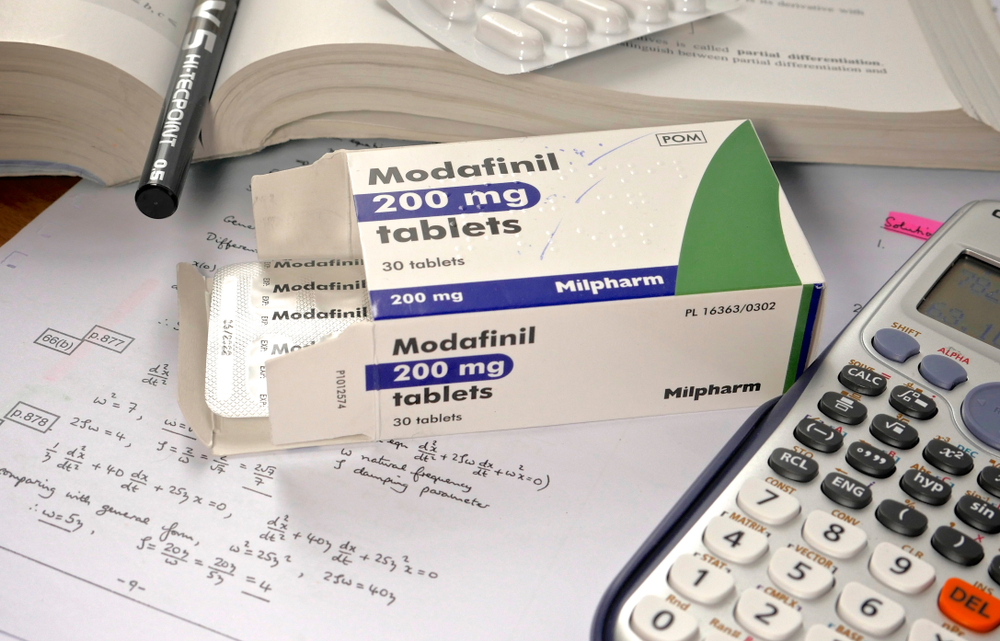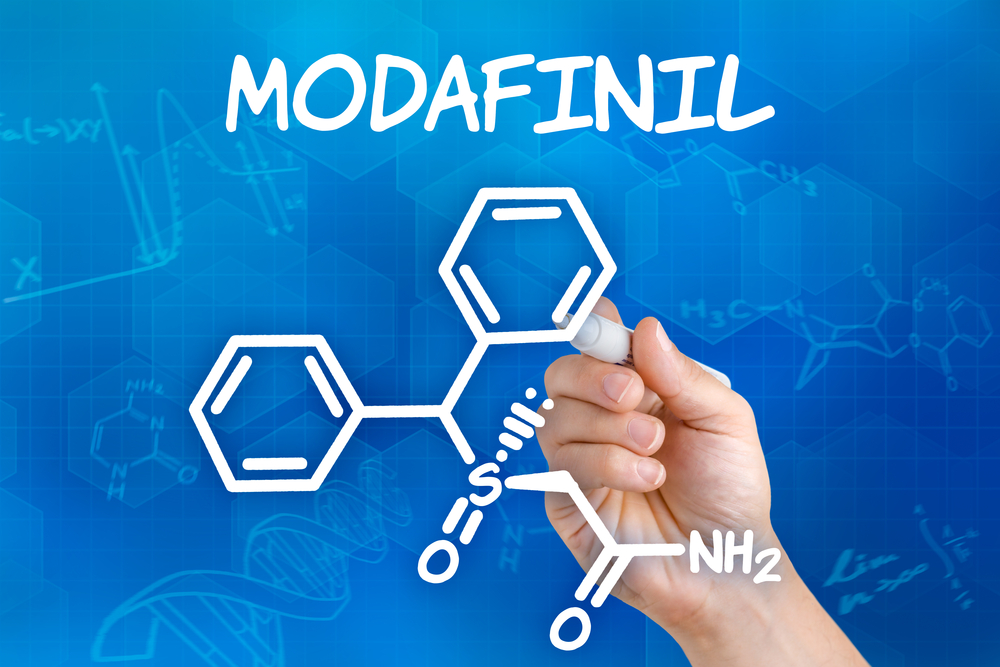Last Updated:
May 16th, 2025
Taking Modafinil as Part of the Detox Process
The cravings that flare up during withdrawal can derail even the most determined people in recovery. Fortunately, there are various forms of detox medication designed to dampen cravings and help make the acute stages of withdrawal more manageable. Modafinil detox medication has become a cornerstone of treatment for various forms of addiction, particularly methamphetamines and cocaine. Modafinil has been shown to reduce cravings and sometimes help with other difficult withdrawal symptoms. Understanding the full scope of modafinil’s effectiveness uses, and potential risks is crucial for making informed treatment decisions.

What is modafinil?
Modafinil, sold under the brand name Provigil, is a central nervous system stimulant. It is a eugeroic drug, which means it has wakefulness-promoting effects. Modafinil is primarily used to treat disorders that affect normal sleep patterns, such as narcolepsy, shift work sleep disorder and obstructive sleep apnea.
While there are various stimulants that can be effective treatments for these conditions, modafinil is often chosen because it generally has a lower risk of addiction and can be used longer-term. This is helped by a modafinil half-life of around 12 to 15 hours, enabling it to promote wakefulness for extended periods. For sleep disorders, modafinil is usually given once a day as a modafinil 200mg pill, though dosage can vary according to individual needs.
Since modafinil’s release, it has also become a popular medication off-label for various conditions other than sleep disorders. These include depression, bipolar disorder, MS-triggered fatigue and modafinil ADHD treatment.
What is modafinil used for?
Modafinil is used for its unique action on the areas of the brain which regulate your sleep-wake cycle. This action is not completely understood yet, but what is clear is that modafinil affects various neurotransmitters like dopamine, norepinephrine, serotonin and your orexin systems. All of these play a vital role in your sleep patterns, alertness and overall mood.
While other stimulants affect many of the same neurotransmitters, they do so more widely. Modafinil’s effects are more pinpointed, targeting the dopamine transporter in particular, which floods your brain with dopamine. These high levels of dopamine make you feel more awake and have made modafinil an important treatment for sleep disorders.
In ADHD patients, modafinil can enhance attention span and executive functioning, making it a viable alternative to traditional, potentially addictive stimulant medications. For those suffering from bipolar disorder, it can be particularly effective in alleviating symptoms of depression without the complication of triggering manic episodes.
How does modafinil reduce cravings and withdrawal symptoms?
It is primarily modafinil’s effects on dopamine that make it so helpful during detox. When you are addicted to drugs like meth and cocaine, giving up suddenly causes intense cravings and other physical and psychological withdrawal symptoms. Fatigue and depression are two common withdrawal symptoms, but modafinil detox medication can help to soothe these symptoms by increasing dopamine levels in the same way it does for sleep disorders and other conditions.
Another benefit of these dopamine increases is that it gives the brain a chance to remember how to function without the drugs it has relied on. Chronic cocaine and meth use cause dopamine levels in the brain to stay artificially high at all times, and eventually, your brain forgets how to trigger dopamine on its own. Modafinil detox medication can keep dopamine levels up when the other drugs are removed, providing a bridge to normal brain functioning.
This transitional support can be crucial in the early stages of recovery, helping to mitigate the harsh symptoms of withdrawal and prevent relapse. At the same time, modafinil detox medication can give you a much-needed mood and energy boost so you can focus on rehab with a clearer mind. As your brain relearns to regulate dopamine without dependence on any external stimulants, modafinil use can then be tapered and finally ended altogether.

Potential modafinil side effects
While Provigil is a generally safe medication, there are some modafinil side effects which may occur in some people. If you experience any of these, it is important to tell your doctors straight away so they can investigate and possibly change your modafinil dose. Some of the most common modafinil side effects include:
This will usually be manageable and mild and will resolve once your body becomes accustomed to Provigil. However, there are some more severe modafinil side effects which can be more dangerous, including:
- Aggressiveness
- Chest pain
- Confusion
- Convulsions
- Detachment from reality
- Diarrhoea
- Extreme anxiety
- Hallucinations
- Heart rate abnormalities
- Increased blood pressure
- Insomnia
- Nausea
- Psychosis
- Restlessness
- Tremors
It is crucial to recognise these symptoms early and seek immediate medical attention to manage an overdose effectively.
Notable modafinil drug interactions
Modafinil detox medication can alter the effectiveness of other medications, potentially reducing their impact or causing more side effects. It is crucial for users, particularly those in recovery from addiction who may be on various medicines, to be mindful of these interactions and to alert their healthcare team right away. Some notable interactions involving modafinil detox medication include:
Contact us today to learn more about modafinil and the detox process
Reach out to our team at Addiction Helper for more information on incorporating modafinil into your detox regime. The road to recovery from addiction can be daunting, but with appropriate support and expert care, success is possible. We can answer any questions you have about modafinil detox medication and help you find the right rehab programme that aligns with your recovery goals.
Our compassionate team are ready and available to take your call, and guide you towards lasting the lasting addiction recovery you deserve.
Frequently Asked Questions
(Click here to see works cited)
- Sangroula, Dinesh et al. “Modafinil Treatment of Cocaine Dependence: A Systematic Review and Meta-Analysis.” Substance use & misuse vol. 52,10 (2017): 1292-1306.
- doi:10.1080/10826084.2016.1276597
Anderson, Ann L et al. “Modafinil for the treatment of cocaine dependence.” Drug and alcohol dependence vol. 104,1-2 (2009): 133-9. doi:10.1016/j.drugalcdep.2009.04.015
WebMD. “modafinil oral: Uses, Side Effects, Interactions, Pictures, Warnings & Dosing.” WebMD, https://www.webmd.com/drugs/2/drug-16962/modafinil-oral/details. Accessed 19 March 2025. - Nuijten, Mascha, et al. “Modafinil in the Treatment of Crack-cocaine Dependence in the Netherlands: Results of an Open-label Randomised Controlled Feasibility Trial.” Journal of Psychopharmacology, 2015, https://doi.org/10.1177/0269881115582151. Accessed 19 March 2025.
- MedlinePlus. “Modafinil.” MedlinePlus, 15 February 2016, https://medlineplus.gov/druginfo/meds/a602016.html. Accessed 19 March 2025.

